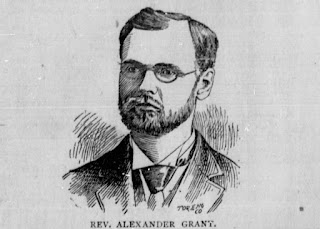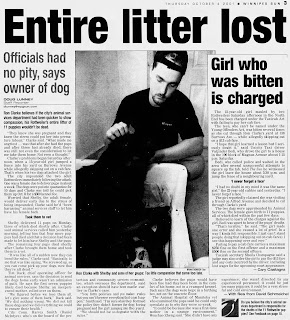The story of 136 Burrows Avenue begins in 1881 when Andrew Grieve Sr. immigrated to Winnipeg from Ross Wade, Scotland.
Grieve was a farmer and came to Winnipeg in order to retire and raise his five sons and two daughters with his wife, Margaret Grey Mann. The family eventually settled on the banks of the Red River at Burrows Avenue where they established a homestead and built one of the first homes on the street.
Unfortunately, only around a decade after immigrating in 1892, the Grieve’s son Thomas passed away at only 35 years old. Over the course of several years, many of his other children moved away, including his daughters who both moved to Saskatchewan, his son John who moved to New York, and his son David who moved to Chicago to study architecture. His son Andrew Jr. remained in Winnipeg and became a prominent member of the music scene, opening a music shop and tuning pianos.
Andrew Grieve Jr. (October 30, 1933), Winnipeg Tribune
In September of 1894, it was announced that David Grieve was working on architecture plans for a grand home on the Grieve property that was to be unlike any other home in the city.
Announcement for the new home’s construction (September 8, 1894), Winnipeg Tribune
Unfortunately, not long after that announcement, in September of 1895, Margaret passed away at 67 years old.
September 20, 1895, Winnipeg Tribune
The resplendent residence at 136 Burrows Avenue was completed soon after. It was built on the property on the southeast foot of Burrows and the riverbank.
The home was built in the Queen Anne style and boasted 2300 square feet, featured two and a half storeys clad in B.C. redwood, a grandiose wrap around porch and second storey balcony, and its stunning feature: a three storey rectangular tower facing the Red River with a view of St. John’s Cathedral.
However, Grieve likely never lived in this architectural marvel built for his family. He instead spent his days next door at 130 Burrows Avenue, the slightly older and much smaller home.
Over the next several years, 136 Burrows was inhabited by various people, including a cashier named T.C. Jones, and later the family of Baptist Rev. Alexander Grant who was the longtime minister at the First Baptist Church and who died in a boating accident in 1897.
September 16, 1893, Winnipeg Tribune
In 1905, the home was bought by pioneer Englishman Joseph Wasdell. Wasdell immigrated to Canada in the 1850s at 21 years old with his wife Mary Ann and children, eventually moving to Winnipeg in the 1881. Here he began business in the hardware industry as a tinsmith in the north part of the city and opened a business at 909 1/2 Main Street with his son Harry.
Ad for a base burner and souvenir range sold by Wasdell (November 20, 1894), Winnipeg Tribune
Harry later lived across the street from the Wasdell house at 135 Burrows Avenue. Joseph shared the 2300 square foot 136 Burrows with several of his children over the time he lived there, including his daughters Julia and Louise, who lived there with their husbands. His wife Mary Ann died in 1907 at 68 years old from heart failure. 10 years later, in 1917, Joseph passed away at 81 and his two daughters inherited the home.
Joseph Wasdell with his grandson (January 24, 1917), The Voice
His daughter Julia in married Jowitt Dunnill in 1892, who was a railway conductor for the Canadian Pacific Railway known as “Big John” Dunnill. He immigrated to Winnipeg from Leeds, England in 1882 and began a three decade-long career with the C.P.R. He was the first conductor to drive a train into the town of Souris, was one of the oldest members of the Order of Railway Conductors, and was personal friends with several of the business elites in the industry like Sir William Van Horne, Sir George Bury, and Sir William Whyte.
Jowitt “Big John” Dunnill (May 28, 1927), Free Press Evening Bulletin
In his later years, he was in a railway wreck that necessitated the amputation of his leg. He was confined to the Burrows residence in a wheelchair and passed away at 67 years old on May 27, 1927.
Julia continued to live in the home for several more decades with her younger sister Louise and was even featured in an article on Burrows Avenue old-timers by Winnipeg Tribune writer and historian Lillian Gibbons in 1946.
May 18, 1946, Winnipeg Tribune
Just months after her interview, in August of 1946 she died at age 72 following a sudden illness. For the following two decades, Louise lived in the home on her own while retiring from a career as a Confidential Secretary and teaching Sunday School at St. John’s Cathedral. Her death in 1965 at 89 years old marked the last Wasdell to live in the home after six decades.
August 9, 1965, Winnipeg Free Press
Over the following few decades, owners of 136 Burrows become less clear. But around 2000, the home was inhabited by Ron Clarke, the owner of two adult Rottweilers.
Clarke, his dogs, and the house made the news for unfortunate reasons in October of 2001 when a 15 year-old girl was dropped off on Magnus Avenue and ran off without paying her $13 fare. A couple of hours later, she cut through Clarke’s yard and was severely mauled by the two canines.
October 4, 2001, Winnipeg Sun
As a result of the incident, both dogs were impounded by the city. And while in custody, the female dog, who was pregnant, prematurely gave birth to her litter and none of the baby dogs survived.
In the two decades since, the house has changed hands again. And even more recently, the newest owners of the home has had some extensive renovation and restoration work done, both on the exterior and interior.
136 Burrows Avenue (2024)
Photos of the interior of 136 Burrows (2024), courtesy of Fred Landry
If the beauty of 136 Burrows, inside and out, is any indication, it’s very possible that this 130 year-old marvel of Illinois ingenuity can easily withstand another 130.


















